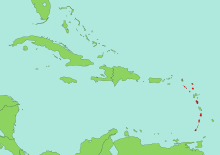East Caribbean dollar
| East Caribbean dollar | |
|---|---|
| Country: |
|
| Subdivision: | 100 cents |
| ISO 4217 code : | XCD |
| Abbreviation: | EC $ |
|
Exchange rate : (August 24, 2020) |
1 USD = 2.7 XCD (fix) 1 EUR = 3.1987 XCD 1 CHF = 2.9725 XCD |
The East Caribbean Dollar (EC $) has been the currency of the Eastern Caribbean Monetary Union or the Organization of Eastern Caribbean States (with the exception of the British Virgin Islands ) since 1965 and is therefore the common official currency in six independent states and two British overseas territories in the Caribbean . These have a common past as British colonies and protectorates , are members of the Commonwealth of Nations and, with the exception of Dominica, have the British monarch as head of state.
The East Caribbean dollar, divided into 100 cents , has been pegged to the US dollar since 1976 at an exchange rate of 1 USD = 2.70 XCD , which is also widely accepted as a second currency.
history
The East Caribbean dollar is the successor to the West Indies dollar that was used in the West Indian Federation . From 1950, in addition to today's countries, Barbados, British Guyana, the British Virgin Islands and Trinidad & Tobago also used the common currency.
It is issued by the Eastern Caribbean Central Bank . This was created on July 5, 1983 by the Eastern Caribbean Central Bank Agreement as the successor to the Eastern Caribbean Currency Authority . The bank is based in Basseterre on St. Kitts .
Banknotes
Banknotes are in circulation with values of $ 5, $ 10, $ 20, $ 50 and $ 100 and, like all coins, bear a portrait of Queen Elizabeth II , who is the head of state of the participating states (with the exception of Dominica ) and territories.
Coins
Coins are in circulation with values of 1, 2, 5, 10 and 25 cents, as well as $ 1. In 2002, the unevenly round coins (1, 2 and 5 cents, $ 1) were changed to round coins in order to keep all coins in the round format.
literature
- Alfred Schipke, Aliona Cebotari, Nita Thacker: The Eastern Caribbean Economic and Currency Union: Overview and Key Issues . In this. (Ed.): The Eastern Caribbean Economic and Currency Union. Macroeconomics and financial systems . IMF, Washington, DC 2013, ISBN 1-61635-265-5 , pp. 3-22.
Web links
- Eastern Caribbean Central Bank (English)
- Banknotes on the ECCB website
- Coins on the ECCCB website
Footnotes
- ^ Phil Rose, Wendell Samuel: The Role of the Eastern Caribbean Central Bank . In: Alfred Schipke, Aliona Cebotari, Nita Thacker (eds.): The Eastern Caribbean Economic and Currency Union. Macroeconomics and Financial Systems . IMF, Washington, DC 2013, pp. 381–404.

